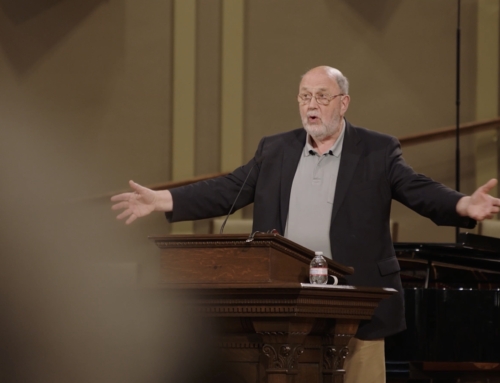Think Like Your Dog
Enrol in Worldviews, the Bible and the Believer at a huge discount through January 31. Don’t miss it!
Nora, a 9 week old Golden Retriever, entered my world almost four years ago. My wife and I had enjoyed the companionship of three other Golden Retrievers in the past, but they had all been adults when we adopted them. This time was different. We didn’t realize how much a puppy could change our world.
Now, to put this in context, you should know that we have two adult children. The presence of this cute, little, impish canine brought powerful flashbacks of having very young children. Suddenly, we were thrust back into the world of sleepless nights in order to tend to ‘puppy issues’.
For instance, during the first several weeks we had to take Nora out every hour or two in order to teach her that going to the bathroom was a task best done outside, even though we live in Wisconsin where the temperatures can regularly hover well below freezing. For a 9 week old puppy, navigating 10 inches of snow on the ground brings its own challenges which easily distract from the task at hand. Frankly, we weren’t ready for a puppy. But there was no turning back.
From Puppy to Well-Trained Dog
So, how does one learn to live with a puppy? Even if she is adorable, she still thinks and acts like a canine, while living alongside the human realm. We were eager to conquer this new challenge, straining though it may be. We questioned whether it was worth the sleepless nights and concerns when Nora decided to eat debris that wasn’t on the approved puppy dietary list! Trips to the veterinarian were frequent, though, fortunately not traumatic. So, how do you ‘do puppy’ and end up with a reasonably obedient, well-trained adult dog?
The experts in the field of dog training urged one basic principle: You must learn to think like your dog. In fact, there is a bestselling book titled Think Like Your Dog And Enjoy the Rewards. We needed to enter Nora’s world; to ‘see’ our world through our dog’s eyes. That is no easy task. It requires study, observation, and diligent discipline, primarily disciplining ourselves to proper attitude, actions, and habits.
Thinking Like Jesus
Now, you are probably wondering, Why all this fuss about our Golden Retriever? I’ll tell you.
One of our emphases at N.T. Wright Online involves how to enter and enjoy Kingdom Living. That is, how do we make the transition from merely human matters to begin to see and live out the world of being ‘in the Messiah’? In other words, how do we see the world and encounter the world as Jesus would have? How do we transition to an ‘In-Messiah’ worldview rather than a ‘purely human’ worldview? This involves far more adjustment than may first be evident.
As many understand, we encounter the world with all of our frailty and with the stain of what the Apostle Paul calls sarx or the flesh. When we become part of the ‘In-Messiah’ people, we are called to adopt a different worldview that leads to a different way of living. This involves adjustments far greater than the ones I had to embrace while ‘thinking like a dog’.
This leads me to introduce some of the elements that Prof. Wright explains in his online course, Worldviews, the Bible, and the Believer. Essentially, a ‘worldview’ is not the world we see but the lenses through which we see and encounter the world. The vast majority of people have no idea that they constantly see the world through built-in lenses. The lenses color and distort our interaction with the real world that exists, for better or worse.
When the Fog Lifts
I’ll never forget entering the city of Guangzhou, China. I traveled from Hong Kong to Guangzhou via train. We traveled through intense fog, which I later found out was actually smog! That explained the ubiquitous use of face masks usually seen in hospitals. The pollution was so bad that each building looked to have a façade of grey bricks, although the city is known for its stunning architecture. Personally, I could hardly see much in front of me, and the atmosphere was bleak, to say the least.
As we entered the train station there was a sudden, deafening noise on the roof of the train. We were in a torrential downpour. I had an even more obscured view because of the density of the rainfall. Then, almost as quickly as the rain started, sunshine broke through. All of the smog that had obscured my view just minutes ago was suddenly removed. The beauty of the city and the real world emerged. Grass was green, foliage was beautiful, and the skyscrapers could be seen to their very heights. Bleakness turned into stunning beauty. My experience changed from dismal tolerance to wonder. In fact, my worldview had changed because the ‘lens’ of the smog was removed.
Many of us don’t realize that our past experiences, and simply being human, inform the way we encounter the outside world: our relationships with other people, our experience of the created realm, our self-image, and, especially, our understanding of God. Because of this, many of us are profoundly hindered (and profoundly unaware to what extent) from seeing the barriers that limit Kingdom-of-God-Living in our lives. God intends for us to experience life to the fullest extent of being in Christ. This, of course, involves the presence of the Holy Spirit. But it also requires us to address the lenses – the worldview – through which we see the world. Not doing so traps us in an existence that is less than what God intended.
The Elements of Worldview
Worldview, as explained by Prof. Wright, includes the following elements: Narrative, Symbols, Praxis (automatic actions and reactions), and Questions. We can break this down further.
Let’s examine the element of symbol using my dog’s worldview, a merely human worldview, and the In-Messiah worldview.
This morning, Nora barked to warn us that an intruder was entering the area. The mail carrier was coming to place a package on our porch. Nora’s bark was extra vigorous, because this was not the usual mail carrier. Jessica, our regular mail carrier, is dearly beloved by Nora. But Jessica was not there. Seen through Nora’s worldview, a dangerous imposter was coming to our house. She had every right to be concerned
My wife and I, however, knew this was the normal time of the day for mail delivery, and that sometimes mail carrier routes change. There was nothing to be concerned about. We were able to properly interpret Nora’s plea for caution, and at the same time reassure her that everything was OK, even though this wasn’t Jessica. There are other times when similar barks of concer, along with a rigid tail, indicate a real threat.
We needed to understand how Nora interpreted the world to properly assess what she was trying to tell us. This required knowing how she interpreted and sent symbols to indicate what was happening from her worldview. These symbols may seem somewhat trivial, until two dogs meet. Unfamiliar dogs send symbols to each other through posture, scent, and noise. When you see teeth, hear growls, and observe rigid tails, neither dog nor owner will interpret this as a ‘friendly encounter’. All the signs indicate ‘Beware’! We know that because we’ve studied it and seen it in action.
Now let’s briefly examine the merely human realm regarding symbols. The American flag is one of the most recognizable (and also one of the most contentious) symbols in the United States and abroad. As we approach one of the most beloved ‘holidays’ in the United States, The Super Bowl, we will find the American flag is front and center. It is displayed in many places within the National Football League environment. That is no accident. The NFL has always been tied to patriotism as part of its marketing strategy, but as tensions over the role of the flag have risen in the past few years, this emphasis has increased. In response to some players declining to stand for the flag and the national anthem, and the backlash from some fans who saw this counter-symbol as dangerous, the NFL has increased their visible use of the American flag. They have also instituted regulations regarding player reactions to these symbols.
Regardless of how you may feel about this particular issue, it is a profound example of how powerful symbol are in viewing the world. Our relationships to the symbol that is the American flag send powerful signals, whether of so-called ‘patriotism’, national superiority, or something else.
These are good things to think about if you regard your allegiance to the Messiah as superior to your allegiance to any country. I am very aware that we have students from 182 countries in our courses. So, issues of national symbols and patriotic observances are varied in both intensity and prominence. The point here is that the symbol will, at times, profoundly indicate and reinforce the worldview of the person.
Finally, let’s look at the worldview of those who are the ‘In-Messiah’ people. The most enduring symbol that we have is the cross. On the surface, it is quite amazing that such a horrid symbol of suffering and death could become a beloved symbol of new life. But it is.
I remember one time when I served as a pastor in a large congregation. A local community wanted to use our sanctuary as the venue for their high school’s graduation ceremony. Some people in the community objected because a cross was prominently ‘built into’ the architecture of the sanctuary. There were letters in protest to the local authorities. There was the request that the congregational leadership would cover up the cross. Church leadership refused the request. For many years, with annual protests by some parents, the high school held graduation ceremonies there… until they built their own auditorium large enough for their needs, where the display of a cross would not be an issue anymore. You may agree or disagree with the position and actions of those involved. The point is the irrefutable impact of the symbol of the cross. It represented many things to many people. It is a powerful image that represents an understanding of who Jesus was and about what he did.
Sometimes when I see a person prominently wearing a cross on a chain or even tattooed on their body, I ask what that means to them. The answers are varied, because there are many interpretations of the symbol. What is clear, though, is that the symbol represents something about their understanding of how they see the world around them and God’s participation in that reality.
At N.T. Wright Online we are dedicated to ‘transformation by the renewal of the mind’ as the apostle Paul says in Romans 12:1-2. Such transformation requires us to understand the worldview that we have and compare it to what is truly the In-Messiah worldview. You will be amazed at how much the merely human worldview rules the day for us. We constantly need to be challenged to reject the merely human worldview and embrace the In-Messiah worldview.
I have found that addressing one’s worldview strikes at the core of human understanding. Yet it is vital for understanding the Bible and essential to understanding your own world. It is quite a challenge. But this is a challenge worth the price of the sacrifice—Jesus’ sacrifice.
David P. Seemuth, PhD
Latest posts by David P. Seemuth, PhD (see all)
- Advent Reflections from the N.T. Wright Online Team - December 5, 2022
- YouTube as Public Reading of Scripture - August 29, 2022
- What I Learned From A Week With Professor Wright - June 16, 2022







